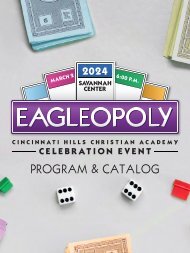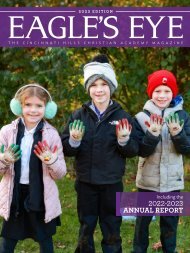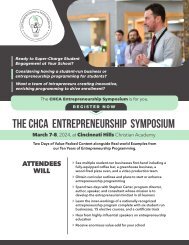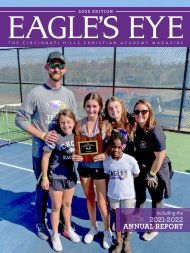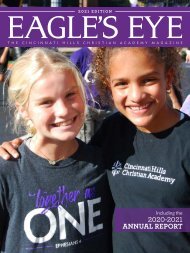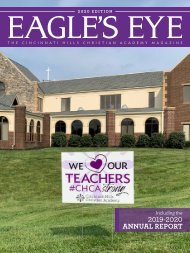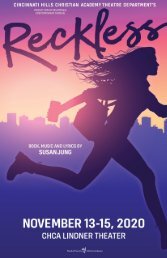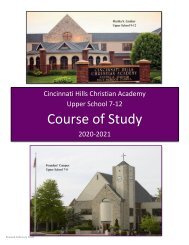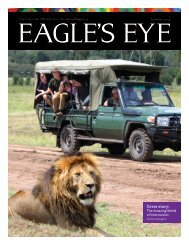Mission, Vision, Competencies, Standards, and Benchmarks
A Statement of Curriculum CINCINNATI HILLS CHRISTIAN ACADEMY Edyth B. Lindner Campus Otto Armleder Memorial Education Center Founders’ Campus Martha S. Lindner Campus 2019 Edition
A Statement of Curriculum
CINCINNATI HILLS CHRISTIAN ACADEMY
Edyth B. Lindner Campus
Otto Armleder Memorial Education Center
Founders’ Campus
Martha S. Lindner Campus
2019 Edition
Create successful ePaper yourself
Turn your PDF publications into a flip-book with our unique Google optimized e-Paper software.
‣ Support an argument that the gravitational force exerted by Earth on objects is<br />
directed down. (4-6)<br />
‣ Use evidence to construct an explanation relating the speed of an object to the energy<br />
of that object. (4-6)<br />
‣ Make observations to provide evidence that energy can be transferred from place to<br />
place by sound, light, heat <strong>and</strong> electrical currents. (K-6)<br />
‣ Ask questions <strong>and</strong> predict outcomes about the changes in energy that occur when<br />
objects collide. (4-6)<br />
‣ Apply scientific ideas to design, test, <strong>and</strong> refine a device that converts energy from<br />
one form to another. (4-6)<br />
‣ Develop a model of waves to describe patterns in terms of amplitude <strong>and</strong> wavelength<br />
<strong>and</strong> that waves can cause objects to move. (4-6)<br />
‣ Develop a model to describe that light reflecting from objects <strong>and</strong> entering the eye<br />
allows objects to be seen. (4-6)<br />
‣ Generate <strong>and</strong> compare multiple solutions that use patterns to transfer information(4-6)<br />
Earth <strong>and</strong> Space Science<br />
Students will underst<strong>and</strong> that…<br />
‣ Human dependence on Earth’s l<strong>and</strong>, ocean, atmosphere, <strong>and</strong> biosphere for many<br />
different resources. Minerals, fresh water, <strong>and</strong> biosphere resources are limited, <strong>and</strong><br />
many are not renewable or replaceable over human lifetimes.<br />
‣ As human populations <strong>and</strong> per-capita consumption of natural resources increase, so<br />
do the negative impacts on Earth unless the activities <strong>and</strong> technologies involved are<br />
engineered otherwise.<br />
‣ Human activities affect Earth’s systems <strong>and</strong> their interactions at its surface.<br />
‣ Human activities in agriculture, industry, <strong>and</strong> everyday life have had major effects on<br />
the l<strong>and</strong>, vegetation, streams, ocean, air, <strong>and</strong> even outer space. But individuals <strong>and</strong><br />
communities are doing things to help protect Earth’s resources <strong>and</strong> environments.<br />
‣ Some resources are renewable over time, while others are not.<br />
‣ Earth’s crust consists of major <strong>and</strong> minor tectonic plates that move relative<br />
to each other.<br />
‣ Science plays a profound role in personal <strong>and</strong> social perspectives relating to natural<br />
resources, environmental quality, health, hazards, <strong>and</strong> global challenges utilizing the<br />
biblical directive to be good stewards from a scientific <strong>and</strong> Christian perspective.<br />
‣ Science is a human endeavor where people interpret scientific knowledge <strong>and</strong> ethical<br />
conduct based on historical context <strong>and</strong> their personal faith <strong>and</strong> beliefs.<br />
‣ God’s Creation reflects His revelation in such verses as: “Ever since the creation of<br />
the world His invisible nature, namely, His eternal power <strong>and</strong> deity, has been clearly<br />
perceived in the things that have been made.” [Rom 1:19-<br />
20] As well: Gen.1,2; Job 38-41; Psalm 19:1-6; Psalm 24:1-2.<br />
Earth <strong>and</strong> Space Science Meta-Skills<br />
‣ Explain how the solar system includes the sun <strong>and</strong> all celestial bodies that orbit the<br />
sun. Each planet in the solar system has unique characteristics.<br />
‣ Identify the sun as one of many stars that exists in the universe.<br />
‣ See predictability in most of the cycles <strong>and</strong> patterns of motion between the Earth<br />
<strong>and</strong> sun.<br />
‣ Identify specific, quantifiable properties of minerals.<br />
‣ Identify <strong>and</strong> classify igneous, metamorphic <strong>and</strong> sedimentary rocks using their<br />
unique characteristics.<br />
Back to Table of Contents




